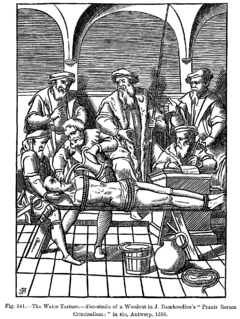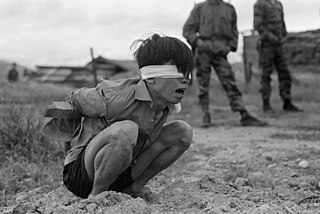 W
WCurious Punishments of Bygone Days is a history book published in 1896. It was written by Alice Morse Earle and printed by Herbert S. Stone & Company. Earle was a historian of Colonial America, and she writes in her introduction: In ransacking old court records, newspapers, diaries and letters for the historic foundation of the books which I have written on colonial history, I have found and noted much of interest that has not been used or referred to in any of those books. An accumulation of notes on old-time laws, punishments and penalties has evoked this volume.
 W
WDoctors of the Dark Side is a documentary about the role of physicians and psychologists in the torture of prisoners. The movie tells the story of four detainees, and how healthcare professionals working for the United States Army and the Central Intelligence Agency implemented enhanced interrogation techniques, and covered up signs of torture at the Guantanamo Bay Detention Camp and Abu Ghraib Prison. Interviews with medical, legal and intelligence experts and evidence from declassified government memos document how the torture of detainees could not continue without the assistance of doctors.
 W
WEmasculation is the removal of both the penis and the testicles, the external male sex organs. It differs from castration, which is the removal of the testicles only, although the terms are sometimes used interchangeably. The potential medical consequences of emasculation are more extensive than those associated with castration, as the removal of the penis gives rise to a unique series of complications. There are a range of religious, cultural, punitive, and personal reasons why someone may choose to emasculate themselves or another person. Consensual emasculation may be seen as a form of body modification which enhances a recipient's connection with the community or sense of self. By comparison, non-consensual emasculations, such as those performed punitively or accidentally, may constitute genital mutilation. The medical treatment for an emasculated person differs depending on whether the procedure was consensual or not.
 W
WThe jetliner position, also known as the captain's chair, is a form of physical torment used in cases where the tormentor is unable or unwilling to inflict corporal punishment on the subject. The recipient is made to put their back against a wall or pole and place their feet eighteen inches or so from the base of the object. The feet are usually kept close together. The subject must then slide down the wall or pole until their thighs are parallel to the ground, so that their profile is of someone sitting in a chair. They may also be required to slide their feet back until their shins and thighs are at right-angles to each other, which makes the stresses upon the knee joints and thigh muscles much greater.
 W
WThe Schwedentrunk is a method of torture and execution in which the victim is forced to swallow large amounts of foul liquid, such as excrement. The name was invented by German victims of Swedish troops during the Thirty Years' War. This method of torture was administered by other international troops, mercenaries and marauders, and especially by civilians following the Swedish baggage train, who received no pay. It was used to force peasants or town citizens to hand over hidden money, food, animals, etc., or to extort sex from women.
 W
WA stress position, also known as a submission position, places the human body in such a way that a great amount of weight is placed on just one or two muscles. For example, a subject may be forced to stand on the balls of their feet, then squat so that their thighs are parallel to the ground. This creates an intense amount of pressure on the legs, leading first to pain and then muscle failure.
 W
WTorture: Journal on Rehabilitation of Torture Victims and Prevention of Torture is a peer-reviewed medical journal on rehabilitation of torture victims and prevention of torture, published triannually by the International Rehabilitation Council for Torture Victims